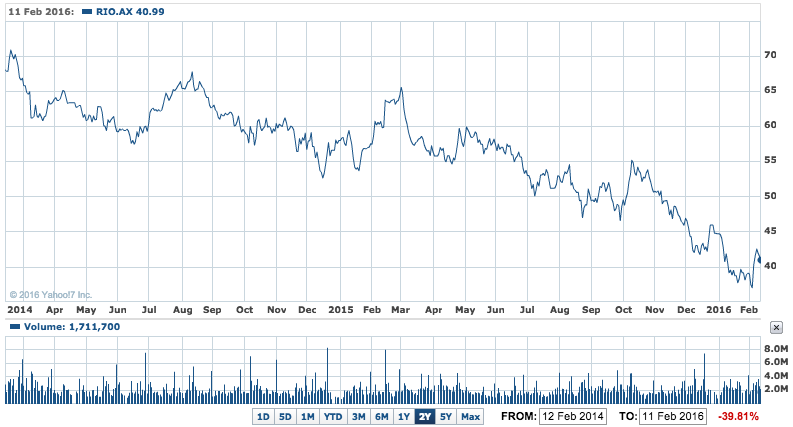No repeat of the Commonwealth Bank’s (CBA) justification for retaining a flat dividend payout to shareholders at Rio Tinto (RIO) – even though it has left its final for 2015 flat, along with the full year return. Rio plans to slash its 2016 payout to shareholders.
The expected 50% slice to the 2016 dividend was justified in similar terms by Rio management, as the CBA board did on Wednesday – its all about setting a dividend payment that can be maintained to shareholders without hurting the financial strength of the group.
Rio kept its full-year dividend at $US2.15 per share, in line with 2014, but said it was now scrapping its progressive dividend policy, the terms of which would have meant the full year payout in US dollars is no less than the previous year. Instead, Rio Tinto will now run a more flexible dividend policy and is seeking to cut a further $US3 billion in capex spending over the next two years after its 2015 earnings halved, as expected, because of the great commodity price slide (especially for iron ore).
For 2016, Rio will now pay a full-year dividend no less than $US1.10 a share for 2016, meaning shareholders can expect a fall in income.
The move had been widely anticipated (and the pressure is now on BHP Billiton to follow suit in a fortnight, which it will almost certainly do). But analysts had been looking for a meaningful cut in dividend.
Rio chair, Jan du Plessis, justified the move in yesterday’s statement, saying “(W)ith the continuing uncertain outlook, the board believes that maintaining the current progressive dividend policy would constrain the business and act against shareholders’ long-term interest….We are therefore replacing the progressive dividend policy with a more flexible approach that will allow the distribution of returns to reflect better the company’s position and outlook.”
In a an explanation of the new policy published in yesterday’s profit announcement, the board said total cash returns to shareholders through the cycle over the longer term were now expected to be “in the range of 40 to 60 per cent of underlying earnings in aggregate through the cycle”.
In other words, the CBA has a policy of paying more – 70% to 80%, but they are in vastly different industries, and yet the board thinking is similar – what can be done to sustain continuing payouts to shareholders and keep the company viable.
RIO 1Y – Rio slumps to loss, relaigns dividend policy

Rio reported underlying earnings of $US4.54 billion for the 12 months to December 31, half the 2014 figure, but not a surprise given analysts had been predicting a slide of this size (down 51%), but roughly in line with analysts’ forecasts. The net result was a loss of $US866 million after taking into account $US3.3 billion of exchange rate and derivative losses, plus $US1.8 billion worth of asset impairments (Nowhere near as big as the impairments at BHP Billiton).
The miner said it would cut capex by a further $US1 billion to $US4 billion this year, and by $US2 billion to $US5 billion next year. Its capex budget for 2015 was $US4.69 billion, in line with previous guidance provided in December for less than $US5 billion.
Underlying earnings from the company’s iron ore division tumbled 51% to $US3.95 billion last year (not hard to understand given the slide in global prices) from $US8.11 billion in 2014, despite Rio’s share of total production rising 13% to 263 million tonnes, and costs again falling.
Earnings from its aluminium division were down 10%, while copper & coal earnings fell 67%.
Rio Tinto shares closed 1.3% lower to $A40.49 on the ASX yesterday.
Rio CEO, Sam Walsh said in yesterday’s statement; “Against a highly challenging environment, Rio Tinto delivered a strong performance in 2015 with underlying earnings of $4.5 billion. We continued to take decisive action to preserve cash through further cost reductions, lower capital expenditure and the release of working capital. This focus on cash resulted in operating cash flows of $9.4 billion.
“At the same time, we have significantly strengthened our balance sheet and finished 2015 with net debt of $13.8 billion, which is $700 million better than the $14.5 billion pro-forma position at the end of 2014.
“The continued deterioration in the macro environment has generated widespread market uncertainty. We are embarking on a new round of proactive measures to cut our operating costs by a further $1 billion in 2016 followed by an additional goal of $1 billion in 2017. We are also reducing our capital expenditure to $4 billion in 2016 and $5 billion in 2017, an overall reduction of $3 billion compared with our previous guidance.
“These significant actions provide us with the confidence that we remain robustly positioned to maintain both balance sheet strength and deliver shareholder returns through the cycle,” he said.













